[1]
Wang XL, Di QF, Zhang RL et al. Progress in theories of super-hydrophobic surface slip effect and its application to drag reduction technology, Advances in mechanics, 40(2010) 241-249.
Google Scholar
[2]
Choi CH, Westin KJA, Breuer KS. Apparent slip flows in hydrophilic and hydrophobic microchannels, Physics of Fluids, 15(2003) 2897-2902.
DOI: 10.1063/1.1605425
Google Scholar
[3]
Choi C, Ulmanella U, Kim J et al. Effective slip and friction reduction in nanograted superhydrophobic microchannels, Physics of Fluids, 18(2006) 087105.
DOI: 10.1063/1.2337669
Google Scholar
[4]
Tretheway DC, Meinharta CD. Apparent fluid slip at hydrophobic microchannel walls, Physics of Fluids, 14(2002) L9-L12.
DOI: 10.1063/1.1432696
Google Scholar
[5]
Ou J, Perot B, Rothstein JP. Laminar drag reduction in microchannels using ultrahydrophobic surfaces, Physics of Fluids, 16(2004) 4635-4643.
DOI: 10.1063/1.1812011
Google Scholar
[6]
Truesdell R, Mammoli A, Vorobieff P et al. Drag reduction on a patterned superhydrophobic surface, Phys. Rev. Lett, 97(2006) 44504.
DOI: 10.1103/physrevlett.97.044504
Google Scholar
[7]
Voronov RS, Papavassiliou DV. Review of Fluid Slip over Superhydrophobic Surfaces and Its Dependence on the Contact Angle, Ind Eng Chem Res, 47(2008) 2455-2477.
DOI: 10.1021/ie0712941
Google Scholar
[8]
Gao P, Geng XG, Ou XL et al. Drag-reduction property of composite structure surface with planar quasicrystal, Acta Physica Sinica, 85(2009) 421-426.
DOI: 10.7498/aps.58.421
Google Scholar
[9]
Rothstein JP. Slip on Superhydrophobic Surfaces, Annual Review of Fluid Mechanics, 42(2010) 89-109.
DOI: 10.1146/annurev-fluid-121108-145558
Google Scholar
[10]
Zhang RL, Di QF, Wang XL et al. Numerical study of wall wettabilities and topography on drag reduction effect in micro-channel flow by lattice boltzmann method, Journal of Hydrodynamics, 22(2010) 366-372.
DOI: 10.1016/s1001-6058(09)60066-4
Google Scholar
[11]
Zhang RL, Di QF, Wang XL et al Lattice Boltzmann Simulation of Flow in a Micro-channel , Chinese Journal of Computational Physics, 28(2011) 225-229.
Google Scholar
[12]
Wang XL, Di QF, Zhang RL et al. The hydrophobic nanoparticles adsorption layer on core surface and its properties, Advanced Materials Research, 465(2012) 239-243.
DOI: 10.4028/www.scientific.net/amr.465.239
Google Scholar
[13]
Barrat JL, Bocquet L. Influence of wetting properties on the hydrodynamic boundary condition at a fluid-solid interface, Faraday Discuss, 112(1998) 121-129.
DOI: 10.1039/a809733j
Google Scholar
[14]
Barrat J, Bocquet L. Large slip effect at a nonwetting fluid-solid interface, Physical Review Letters, 82(1999) 4671-4674.
DOI: 10.1103/physrevlett.82.4671
Google Scholar
[15]
Voronov R, Papavassiliou D, Lee L. Slip length and contact angle over hydrophobic surfaces, Chemical Physics Letters, 441(2007) 273-276.
DOI: 10.1016/j.cplett.2007.05.013
Google Scholar
[16]
Carman PC. Fluid flow through a granular beds, Transactions of the Institution of Chemical Engineers, 15(1937) 150.
Google Scholar


